High water consumption? Check for leaks in your water line – MCWD
MCWD exec says that is most likely the cause and not a faulty meter

FILE PHOTO
CEBU CITY, Philippines — An official from the Metropolitan Cebu Water District (MCWD) urged its consumers to check their meters every now and then to determine if there is a leak in their line.
In a recent interview with Sugboanon channel, MCWD Public Information Officer Minerva Gerodias addressed the complaints of its consumers regarding high water bills and the lack of water supply in their areas.
Gerodias explained that an increase in water bills is because of the purchased water adjustment (PWA) and the power cost adjustment (PCA) that MCWD charges.
READ MORE:
Cebu City: Water crisis eases as La Niña brings rain
DENR wants water districts to own refilling stations
The PWA is imposed on the consumer considering the cost of water supply, which would cost around P65 per cubic meter and P73 for desalination, and there would be adjustments considering its costs.
“If taas ang imong cubic meter this month, mosaka ang imong PWA in two months. Dili nga ang PWA on this month, mao ang PWA for your consumption sa current month. Kay delayed ang pag compute ana niya sa total na gipalit nga bulk water from our suppliers,” Gerodias said.
(If the cubic meter of water his month is high, your PWA will also increase in two months. Not your PWA on this month, that is the PWA for your consumption for the current month. Because the computation of that is delayed, that is the total bulk water that we bought from our suppliers.)
Meanwhile the PCA includes the electricity that was used in order to power the water pumps. Consumers have a share in paying the electric bill for the water pumps or other parts that would need electricity.
Gerodias also addressed the misconception that it is because of damaged meters that there is high water consumption in a household.
She explained that if the meter is damaged, it would be a loss on MCWD’s part, so there would always be a periodic change of meters within the seven to ten years it was installed.
If there would be an increase in the usual water consumption, Gerodias said that there would be a 90 percent chance that it would be because of a leak.
“Kung niagi og leak inyung system, niagi man na sa meter no. Mahug siya na water consumed siya. So kung nag-leak mo, butang natu June, nisaka ang inyuhang consumption, nisaka ang cubic meters nga na consume for this month. Mo expect mo ana na in two to three months, motaas inyu PWA kay adtu pa na siya ma charge.”
(If your system has a leak, and it passes through the meter. That will be considered as a consumed water. So if you have a leak, let’s say in June, your consumption increased, then the cubic meters consumed for this month also increased. Then you expect that in two to three months your PWA will increase because it will be at that time that it will be charged to you.)
Gerodias added that there were some cases where the leak is not visible, as in one case where the water bill for two individuals in one household was worth P20,000 because there was a leak in the water pipe that was buried underground.
Because there was a leak in the pipe, the water wasted went towards the ground and not outside, as such the household was not aware of the leak in their water line.
The simplest way to check for leaks is to close or turn off all faucets at home and then check the meter. If it is turning, then there is a leak, or pilferage. But cases of water pilferage is less compared to leaks in water lines.
Another thing to check is the flush in toilets, as the rubber or flapper preventing water to flow into the toilet might not be water-tight anymore, causing water to drip and increasing water consumption in the household.
Gerodias encouraged consumers that if there are leaks in water supply, it should be addressed as soon as possible because since it went through the meter, it would be charged. This would increase water consumption, as well as the PWA and PCA.
“Ang leak kay high risk sad na siya sa atu health kay kung mo low ang pressure unya naay bangag ang inyung tubo, mosulod diha ang kagaw. Unya once mobalik ang pressure, madala ang kagaw sa inyuhang gripo ug unya magamit ninyu nang hugaw na tubig, ” she added.
(The leak is also a high risk to our health because if their will be a low pressure then germs or dirt can enter the hole from the tube or line. Then once the pressure would return, the dirt or germs will be transported to your water faucets and you will then be using dirty or contaminated water.)
In places like Barangay Lorega San Miguel, Gerodias explained that because they are at the end of the distribution line partly from Carmen and from Talamban, they might have less water supply.
However, there might be an improvement once desalination plant in Mambaling is completed, increasing water supply in areas too far from the distribution line.
Disclaimer: The comments uploaded on this site do not necessarily represent or reflect the views of management and owner of Cebudailynews. We reserve the right to exclude comments that we deem to be inconsistent with our editorial standards.
